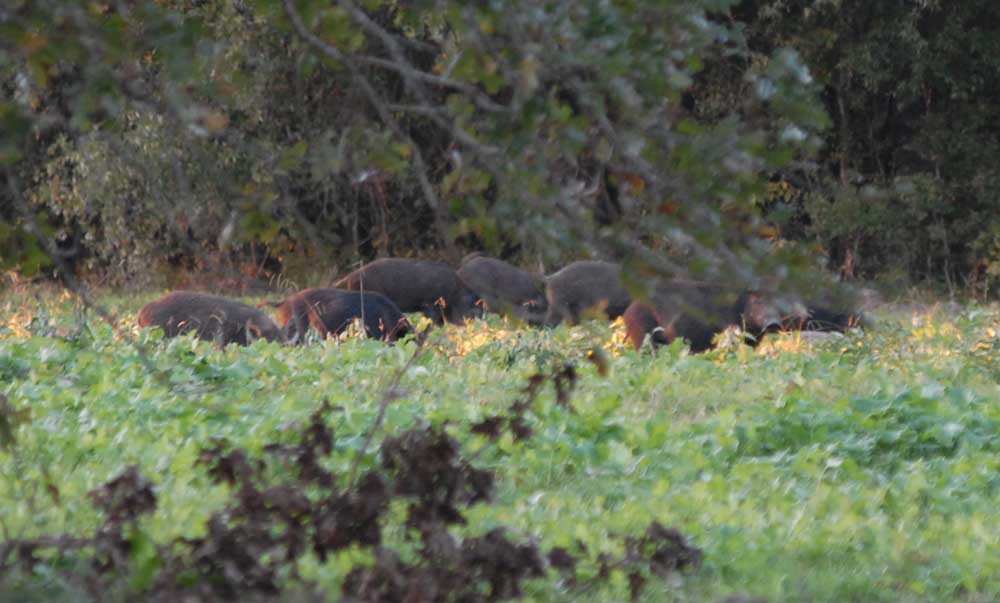Pig Patrol: No license to hunt pigs will help but won’t solve the problem
Published 8:18 pm Saturday, June 15, 2019

- With close to 3 million wild pigs ranging through Texas, anything will help reduce numbers. Starting Sept. 1, no one will need a license to hunt pigs statewide.
It is another tool in the toolbox, but at its very best it’s not really going to be big enough to fix the problem.
Earlier this month Texas Gov. Greg Abbott signed legislation introduced by State Sen. Bryan Hughes of Mineola that will allow anyone to shoot wild pigs without a license. Prior to the legislation, which takes effect Sept. 1, pig hunters had to have a license or be hunting on their own property.
With millions running across all 254 counties of the state the pigs are an ecological, agricultural, financial and wildlife nuisance.
Wild pigs are not new to Texas. It is believed they were here about 200 years before it was even a state, having been brought to the new world by the French explorer LaSalle in 1685.
When Texans were still predominately rural residents pigs often had free rein of the woods especially in the fall in East Texas where they got fat on falling acorns. Their owners would at some point gather them back up, but invariably a few escaped and became wild.
Late in the 20th century the wild pigs became popular with hunters. So popular it seems that some of those who were without them thought it might be a good idea to import them and establish a population. That began a population explosion as the new herds backfilled to existing populations and advanced forward into new country across the state. El Paso County was the last to report having wild pigs, and while it still officially is not listed as a county with them there have been sightings along the Rio Grande River
At this point there may be no stopping the pigs. Controlling them is probably the best hope. The problem is pigs are prolific. Females can be bred the first time as young as five months old and they can have up to two litters a year. There is also a high rate of survival of the young.
Conversely they have no real natural predators to speak of, and hunting alone has little impact. Texas AgriLife Extension Service guesstimated almost a decade ago that hunters and trappers combined were taking only about 29 percent of the population annually. That was before the state approved helicopter hunting which last year accounted for the harvest of 43,000 pigs, according to Texas Parks and Wildlife Department. There have been no permits sought for hunting from a hot air balloon, although it is legal.
“No agency or group is counting wild pigs. Census methods have not been developed to give accurate estimates,” said Jim Cathey associate director Texas A&M Natural Resources Institute. “Modeling work done by Texas A&M Natural Resources Institute back in 2012, used published literature and density estimates to calculate a range between 1.8 to 3.4 million pigs with an average of 2.6 million. We also noted that it would take 66 percent annual harvest just to hold the population level. Just given the math, wild pig numbers are up.”
Based on a population of 2.6 million that means 1.72 million pigs would have to be removed annually to maintain status quo. Best guess estimates are only about 754,000 were being taken by all means.
To help get some up-to-date information on wild pigs Cathey said a website, wildpigs.nri.tamu.edu, was created to allow landowners to learn about wild pigs, sightings, numbers and other data and self-report damage caused by the animals.
“We have had 1,157 reports since Oct. 5, 2018. These people reported sightings of 13,453 juveniles and 9,502 adult wild pigs from 177 Texas counties. The most commonly reported damage was rooting, but other categories were also reported. It was interesting to see the responses of damage to lawns and landscapes. Wild pigs are now fairly common even in suburban areas of Texas and I often get calls from frustrated homeowners,” Cathey said.
Cathey said wild pigs also cause tens of millions of dollars in damage to farm crops along with untold damage to wetlands, plant and animal communities.
“If you think about just the animal equivalent of a 200-pound pig live on the hoof and not all of the nutrients to get them to 200 pounds or to sustain them at that level, we could have had 582 bobwhite quail, 610 mourning dove or 1,455 Texas horned lizards,” he explained.
While supporting the effort to increase the hunting of pigs that the legislation allows, Cathey stops short of saying it will turn the tide in control efforts.
“With the justification (of damage caused) and knowing the confusion expressed from my audience members as it relates to wild pig depredating an agricultural commodity or not, this legislation helps clarify the law and it allows people to help maintain native wildlife otherwise exploited by this exotic species invader, the wild pig,” Cathey said.
Harvest by gun is just not efficient enough primarily because it is a one-shot chance. After a single shot, successful or not, any other pigs around will run away. Too much pressure on one property either pushes the pigs into dense cover or onto the next property.
A toxicant remains the best hope for a solution. Texas Department of Agriculture attempted to allow the use of a warfarin-based bait, but the developer vacated the state after an uproar about the lack of testing its potential impact on other non-intended species.
TPWD and others continue to look at sodium nitrite as an option.
“We will have another field trial coming up in Alabama on free-ranging pigs this summer. Things are moving in a positive direction, but moving slowly,” said John Kinsey, who leads the study for the department in Texas.







